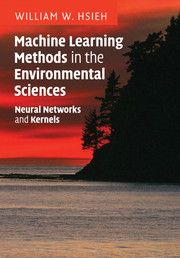Book contents
- Frontmatter
- Contents
- Preface
- List of abbreviations
- 1 Basic notions in classical data analysis
- 2 Linear multivariate statistical analysis
- 3 Basic time series analysis
- 4 Feed-forward neural network models
- 5 Nonlinear optimization
- 6 Learning and generalization
- 7 Kernel methods
- 8 Nonlinear classification
- 9 Nonlinear regression
- 10 Nonlinear principal component analysis
- 11 Nonlinear canonical correlation analysis
- 12 Applications in environmental sciences
- Appendices
- References
- Index
12 - Applications in environmental sciences
Published online by Cambridge University Press: 04 May 2010
- Frontmatter
- Contents
- Preface
- List of abbreviations
- 1 Basic notions in classical data analysis
- 2 Linear multivariate statistical analysis
- 3 Basic time series analysis
- 4 Feed-forward neural network models
- 5 Nonlinear optimization
- 6 Learning and generalization
- 7 Kernel methods
- 8 Nonlinear classification
- 9 Nonlinear regression
- 10 Nonlinear principal component analysis
- 11 Nonlinear canonical correlation analysis
- 12 Applications in environmental sciences
- Appendices
- References
- Index
Summary
In this final chapter, we survey the applications of machine learning methods in the various areas of environmental sciences – e.g. remote sensing, oceanography, atmospheric science, hydrology and ecology. More examples of applications are given in Haupt et al. (2009).
In the early applications of methods like NN to environmental problems, researchers often did not fully understand the problem of overfitting, and the need to validate using as much independent data as possible, by e.g. using crossvalidation. For historical reasons, some of these early papers are still cited here, although the control of overfitting and/or the validation process may seem primitive by latter day standards.
In some of the papers, the authors used more than one type of machine learning method and compared the performance of the various methods. A word of caution is needed here. In our present peer-reviewed publication system, a new method can be published only if it is shown to be better in some way than established methods. Authors therefore tend to present their new methods in the best possible light to enhance their chance of passing the peer review. For instance, an author might test his new method A against the traditional method B on two different datasets and find method A and B each outperformed the other on one dataset.
- Type
- Chapter
- Information
- Machine Learning Methods in the Environmental SciencesNeural Networks and Kernels, pp. 274 - 317Publisher: Cambridge University PressPrint publication year: 2009



